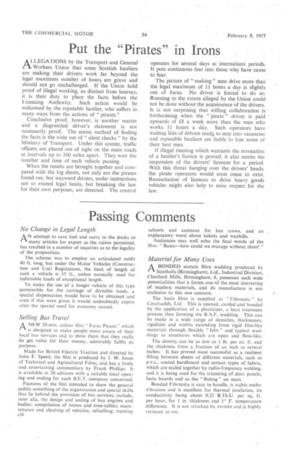Passing Comments
Page 32

Page 33

If you've noticed an error in this article please click here to report it so we can fix it.
No Change in Legal Length
A N attempt to save fuel and carry to the docks as 1-1 many articles for export as the ration permitted, has resulted in a number of inquiries as to the legality of the proposition.
The scheme was to employ an articulated outfit 40 ft. long, but under the Motor Vehicles (Construction and Use) Regulations, the limit. of length -of such a vehicle is 35 ft., unless normally used for. indivisible loads of exceptional length.
To make the use of a longer vehicle of this type permissible for the carriage of divisible loads, a special dispensation would have to be obtained and even if this were given it would undoubtedly expire after the special need for economy ceased.
Selling Bus Travel
A NEW 20-min. colour film "Fares Please," which 1—k is designed to make people more aware of their local bus services and to show them that they really do get value for their money, admirably fulfils its purpose.
Made for British Electric Traction and directed by John F. Speed, the film is produced by J. W. Jones of Technical and Agricultural Films, and has a lively and entertaining commentary by Frank Phillips. It is available in 20 editions with a suitable local opening and ending for each B.E.T. company concerned.
Features of the film intended to show the general public something of the organization and special skills that lie behind the provision of bus services, include, inter alia, the design and testing of bus engines and bodies; compilation of routes and time-tables; maintenance and cleaning of vehicles; refuelling; training A30 schools and canteens for bus crews, and an explanatory word about tickets and waybills. Audiences may well echo the final words of the "Buses—how could we manage without them!"
Material for Many Uses
A BONDED acetate fibre wadding 'produced by " Southalls (Birmingham), Ltd., Industrial Division, Charford Mills, Birmingham, 8, possesses such wide potentialities that it forms one of the most interesting of modern materials, and its manufacture is not exclusive to this one concern.
The basic fibre is supplied as " Fibroceta " by Courtaulds, Ltd. This is opened, carded and bonded by the application of a plasticizer, a heat treatment process then forming the B.A.F. wadding. This can be made in a wide range of densities, thicknesses, rigidities and widths extending from rigid film-like materials through flexible " fetts " and typical waddings to structures which are open and floss-like.
The density can be as low as lc lb. per cu. ft. and the thickness from a fraction of an inch to several inches. It has proved most successful as a resilient filling between sheets of different materials, such as p.v.c., coated hardboard and certain types of fabric, which are sealed together by radio-frequency welding, and it is being used for the trimming of door panels, facia boards and as the " fluting " on seats.
Bonded Fibroceta is easy to handle, is stable under vibration and is excellent for thermal insulation, its conductivity being about 0.25. B.Th.U. per sq. ft. per hour, for 1 in. thickness and 1° F. temperature difference. It is not attacked by vermin and is highly resistant to rot.
Mexborough and Swinton Jubilee
CONGRATULATIONS to the Mexborough and Swinton Traction Co., Ltd., a member of the British Electric Traction Group, who have just celebrated their Golden Jubilee, to the chairman, Mr.
R. Williams, M.A., M.Inst.T., and Mr. D. R. Vernon, A.M.Inst.T., the general manager.
The company started on February 1. 1907, with trams. These picked up power from studs between the rails which, through becoming " live " unexpectedly, caused frequent accidents to horses and dogs. This Dolter system was discarded in 1908 for overhead lines.
In August, 1915, two short trolleybus lines were constructed, and operated with single-deckers having Daimler chassis and Brush bodies, but in 1922, they were replieed by A.E.C. single-deckers.
Extensions were made.and in 1928, some Garrett vehicles were added, whilst all the trams were withdrawn in 1929.
Some used trolleybuses were purchased in the earlier war years and in 1943, six new Sunbeam chassis with Brush utility bodies were added. These Sunbeams were sold to Doncaster Corporation in 1954, and with new bodies, are expected to serve for a further 12 years.
Of the fleet a 33 trolleybuses, 32 are now Sunbeam-Brush, which in 1955. carried a total of over 12m. passengers.
Motorbuses have been in use since November, 1922, and until 1954 were all used models. Following this, various new makes were bought and sold, but early in 1954, 10 Leyland Tiger Cub buses were purchased and are now running. Some of the trolleybus and motorbus services are jointly operated with Rotherham Corporation Transport.
An excellent private hire and contract carriage ser vice has been developed in recent years, and last year the company operated for the first time a number of excursions, and tours.
The first full year in which the present services were
run was 1955, when the fleet of 12 single-deckers carried 51m. passengers.




































































































